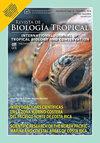在墨西哥南部的拉坎东森林,森林砍伐增加了啮齿动物及其体外寄生虫的数量
IF 0.6
4区 生物学
Q4 BIOLOGY
引用次数: 0
摘要
热带森林提供的重要生态系统服务是疾病控制。然而,很少有研究关注于分析森林砍伐如何影响更适合作为人畜共患病媒介的物种。目的:研究森林砍伐对墨西哥南部恰帕斯州科米利亚斯侯爵地区啮齿动物及其相关体外寄生虫数量和物种丰富度的影响。方法:在树木覆盖率分别为0.7、5%、40%、46%、78%和95%的6个景观单元(每个景观单元面积1 km²)内捕获鼠类。在每个LU中,我们在2019年10月和2020年9月的两个采样季节设置了90个谢尔曼陷阱,这些陷阱在7天内24小时保持活跃。所有捕获的啮齿动物都被检查了皮毛上的外寄生虫,这些寄生虫被收集起来在实验室进行鉴定。结果:共捕获长毛齿齿鼠、长马氏异齿鼠、叶状耳齿鼠、墨西哥长齿鼠和长齿鼠5种鼠类70只。随着森林的减少,啮齿动物的数量增加(R²= 0.706,P = 0.022)。森林覆盖率中等的样地鼠种丰富度最高,分别为40%和78%。以S. toltecus (N = 45)最多,其次是O. couesi (N = 9),在森林覆盖较少的样地占优势。我们一共记录了23种不同的体外寄生虫,其中15种被鉴定为种,8种被鉴定为属。我们检测到三种已知为人畜共患疾病媒介的体外寄生虫(Amblyomma sp., Ornithonyssus bacoti和Androlaelaps fahrenholzi)。结论:我们发现,森林的持续减少促进了人畜共患疾病媒介的扩散,这可能会增加当地人口中感染的频率。本文章由计算机程序翻译,如有差异,请以英文原文为准。
Deforestation increases the abundance of rodents and their ectoparasites in the Lacandon forest, Southern Mexico
Introduction: An important ecosystem service tropical forests provide is disease control. However, few studies have focused on analyzing how species more suitable to be zoonotic vectors are affected by deforestation. Objective: We evaluated how deforestation affects the abundance and species richness of rodents and their associated ectoparasites in Marques de Comillas, Chiapas, Southern Mexico. Methods: We captured rodents in 6 landscape units (LU), 1 km² each, with different percentages of tree cover (0.7, 5, 40, 46, 78, and 95 %). In each LU we set 90 Sherman traps that remained active 24 hours for 7 days during two sampling seasons in October 2019, and September 2020. All the captured rodents were checked for ectoparasites in their fur, which were collected to be identified at the lab. Results: We captured 70 rodents of five species: Sigmodon toltecus, Heteromys desmarestianus, Ototylomys phyllotis, Peromyscus mexicanus, and Oryzomys couesi. Rodent abundance increased with forest loss (R² = 0.706, P = 0.022). The greatest richness of rodent species occurred in sites with intermediate forest cover (40 % and 78 %). The most abundant species were S. toltecus (N = 45) followed by O. couesi (N = 9), these species dominated in sites with less forest cover. We recorded a total of 23 different ectoparasites, from these we identified 15 at the species level and eight at the genus level. We detected three species of ectoparasites (Amblyomma sp., Ornithonyssus bacoti, and Androlaelaps fahrenholzi) known to be vectors of zoonotic diseases. Conclusions: We found that the ongoing loss of forests promotes the proliferation of zoonotic disease vectors, which can potentially increase the frequency of affectation among the local population.
求助全文
通过发布文献求助,成功后即可免费获取论文全文。
去求助
来源期刊

Revista De Biologia Tropical
生物-生物学
CiteScore
1.80
自引率
0.00%
发文量
23
审稿时长
4-8 weeks
期刊介绍:
The Revista de Biología Tropical / International Journal of Tropical Biology and Conservation is a mainstream scientific journal published since 1953 and covered by Web of Science; Science Citation Index; Current Contents; Google Scholar; Scopus, SciELO and nearly 50 additional indices.
A double blind system guarantees you a fair evaluation, and our world class editorial and scientific boards provides a first decision in three working days. The journal is Full Open Access and is widely read where your article can have the highest real impact.
Since its beginning in 1953, the Revista follows these principles: objective and independent evaluation of all manuscripts; transparency in all processes; ethical use of procedures, data, specimens and subjects; fair treatment of all parties; and absolute predominance of scientific rigor over any other aspect.
 求助内容:
求助内容: 应助结果提醒方式:
应助结果提醒方式:


